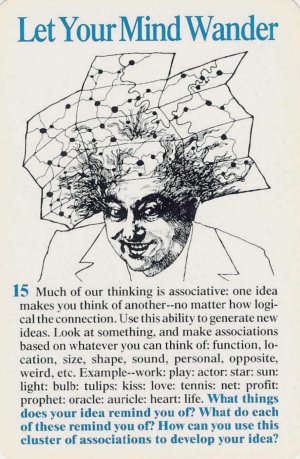A few days ago I asked a question on twitter: What is Pricing Power?
Yesterday, I asked another one: What is Staying Power?
I wanted to illustrate the power of focused thinking by “letting your mind wander.” What happens when you think about an idea and that idea only from multiple points of view?
Well, you get insights you wouldn’t get if you were distracted by other ideas.
Staying power is a very powerful idea. But where does it come from? The common answer I get from people is that it comes from a strong balance sheet. But that’s only part of the answer.
You have to keep asking where else does it come from. And one way to find out is by asking where does a strong balance sheet come from?
The insights gained through focused thinking on a question and that question alone produced some answers which I think will be useful for you. These are listed below. Remember that this is not an exhaustive list but is a pretty good first attempt to answer the question.
Business Model
From the vantage point of a business model, staying power comes from:
- A product or service that will not be obsoleted for a long time – usually these are things that serve basic human needs and aspirations.
- Multiple sources of revenue streams.
- Low customer concentration risk.
- Low supplier concentration risk especially when dealing with critical raw materials.
- A business which does not derive its key advantages from political clout.
- Slack in the form of un-utilised capacity especially in case of industries when most money is made during periods of shortages.
- High customer switching costs (financial or psychological e.g. in brands)
- Solid entry barriers which prevent a business from a competitive attack that can destroy it.
Corporate Culture
From the vantage point of corporate culture, staying power comes from:
- Willingness to cede market share when irrational competition drives down potential returns – and in the extreme case exiting a businesses.
- Refusal to invest in a business which deserves to die – i.e. not throwing good money after bad – and conserving it for productive uses.
- Unwillingness to bet the bank on a single idea – intelligent risk management as part of the DNA of the firm (including avoidance of gambling in the garb of risk management through derivatives).
- Willingness to make multiple small bets to grow the business so that no single bet or a group of bets, if they turn bad, can destroy the business.
Ownership Structure
From the vantage point of ownership structure, staying power comes from:
- Rich promoters who will, when needed, add financial strength to the business by infusing their own cash when no one else will (usually happens in family run businesses)
- Controlling stockholders who support investment for future prosperity instead of treating the business like a cash cow (although doing that makes sense in many circumstances)
- An ownership structure which, when combined with a great management team, creates stability for the firm e.g. through non voting shares (e.g. Google)
Balance Sheet
From the vantage point of balance sheet, staying power comes from:
- Low or no debt levels whether on or off balance sheet.
- A liquid balance sheet.
- Presence of non operating assets that can be sold for cash to save the business when needed.
- Absence of other encumbrances e.g. litigation that can drain resources or managerial focus.
- Low short-term debt, especially during cyclical downturns.
Profit and Loss Account
From the vantage point of P&L, staying power comes from:
- Size of revenues – generally speaking large businesses have better ability to withstand economic shocks than smaller ones.
- Multiple sources of earnings.
- Pricing power.
- Low cost advantage over competition so when industry conditions worsen the others suffer a lot more than you.
- Flexible cost structure – the ability to shrink the business without losing profit margins – low operating leverage.
- Low financial leverage as reflected by low interest cost in relation to earnings available to pay interest.
- Low economic depreciation – coming from a business that is not very capital intensive, and one that is not prone to become obsolete soon.
- Significant discretionary spending which can be curtailed during really bad economic and industry conditions – e.g. advertising.
Cash Flow Statement
From the vantage point of cash flow statement, staying power comes from:
- Low interest and principal repayments in relation to operating cash flow.
- Low maintenance capex and maintenance working capital needs.
- Ability to fund even growth and maintenance capex with internal resources.
- Low dividend payouts.
The Investor
From the vantage point of the investor, staying power comes from:
- Large number of years left to invest.
- Ability to handle volatility through financial strength – low or no debt and significant disposable income preventing the need to liquidate portfolio during inappropriate times.
- A frugal nature.
- Ability to handle volatility through psychological strength.
- A very long-term view about investing.
- Structural advantages – investing your own money or other people’s money who will not or cannot withdraw it for a long long time.
- Family support during tough times.
Creative thinking can be taught. It can be learnt. It requires deliberate practice. One of my favourite tools for creative thinking is Creative Whack Pack — a pack of cards that make my creative juices flow. Buy these cards. The author also sells them as an app for your smartphone. Buy the app. Here are a few cards I used for this particular exercise. 

This post is the outcome of the efforts of many twitter followers. Thank you.
END




Thank you. Multiplies by infinity!
Sorry I meant, multiplied by infinity!
corporate should have the culture for flexibility/adoptibility/skills and vision to adopt the changes of product/services as per changes required or customer need ilke bajaj change from scooter to bike .hero moto able to manage even after exit of honda etc
Thank you Sir for sharing your insightful thoughts on this subject. I would like to add a couple of points which I think also contribute to the staying power from the vantage point of the following heads :
Corporate Culture
Staying power can also come from doing business with a strong value system and a culture of ‘ethics’. Having a trusteeship mentality is a more evolved form of such a culture. Eg: Tata
and Godrej group may not have been the largest wealth creators but they have lasted for more than 100 years due to a strong value system.
The Investor
Ability to take advantage of volatility by having access to a continuous stream of cash flows through ownership in an operating business generating healthy free cash flows (like See’s Candies) or float(like insurance) or other people’s money at demand. Having ready cash at demand can make a big difference in performance and staying power of an investor.
Thanks and Regards.
Saurav Jalan
[…] What Is Staying Power?: Fundoo […]
[…] Fundooprefessor with a great post on the potential “staying power” of companies […]
[…] What is Staying Power? Interesting read on what staying power is in multiple contexts. […]
Dear Sir,
I am a novice in investing but I understand the value of brands in a country where the potential customer can be 1.2b.
I want to talk about a company which is very well known to us called “Arvind”
On the prima facie company’s balance sheet looks stretched and it is a horrendous task to try to understand the balance sheet. However there are key features which I understand of the company and it’s balance sheet.But I would like to talk about the Business Model.
1. Arvind has one of the most widely accepted brands with it.(USPA, GAP, Tommy Hilfiger, Gant, Ed Hardy etc ).
2. With the youngsters now more oriented towards brands, it can be fairly expected that the branded product growth rate can be as high as 30% CAGR in the future. It is already growing by 25% in terms of sales.
3. I stay in Bangalore and I have observed here that now even office goers wear USPA t-shirts which was not the case before as company rules were strict about the dresses. Now just think if lakhs of people employed in IT starts wearing these branded semi casual products how much can be the increase. I have seen that IT people somehow seem to have a lot of disposable income.
4. It is a fully integrated business where the company makes yarn to final product.
5. The size of branded garment Industry is huge and it is growing at a rate of 10% every year and expected to grow around 15% for the next few years.
On Balance Sheet
1. Debt is huge which implies it is in capital intensive business. ( According to my understanding it is because of addition of spinning capacities and branded show rooms but I am not sure)
2. Working capital requirements are high. Capital turns look like 3 times only.
3. Pat margins looks very less but they are expected to increase with increase in branded product sales (expected) also with the reduction in interest costs.
On P&L
1. Depreciation is high and company has no big Capex plan as of now.
2. Somehow branded products are not contributing to profits. May be this is because of brand building expenditure that the company is doing.
3. Operating profits have risen at a phenomenal pace (25%) in the last five years and debt increment has been less than 7 percent.
Kindly give your views and help me the aspects on which I should ponder upon before investing in Arvind
[…] and thrive in even the worst of times have “staying power”. There was recently an awesome post by Sanjay Bakshi that listed a variety of examples of traits that constituted staying power. A few […]